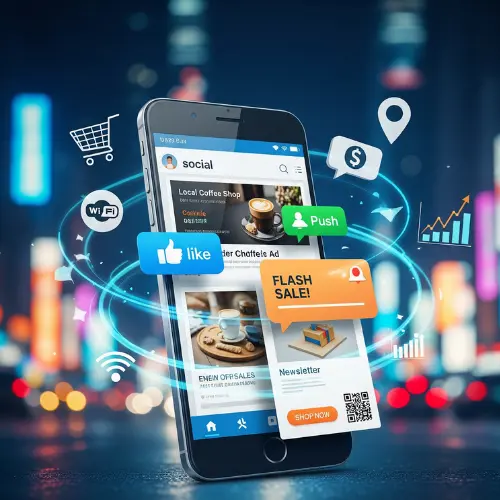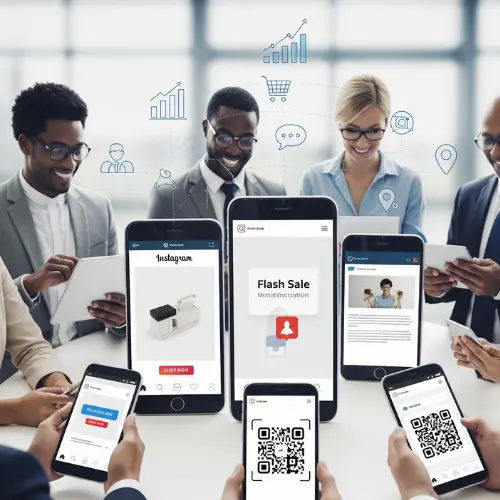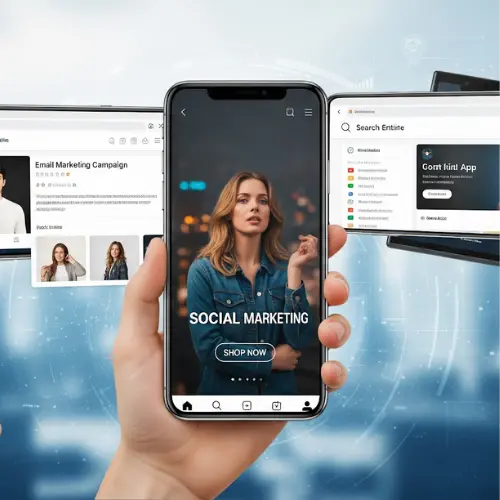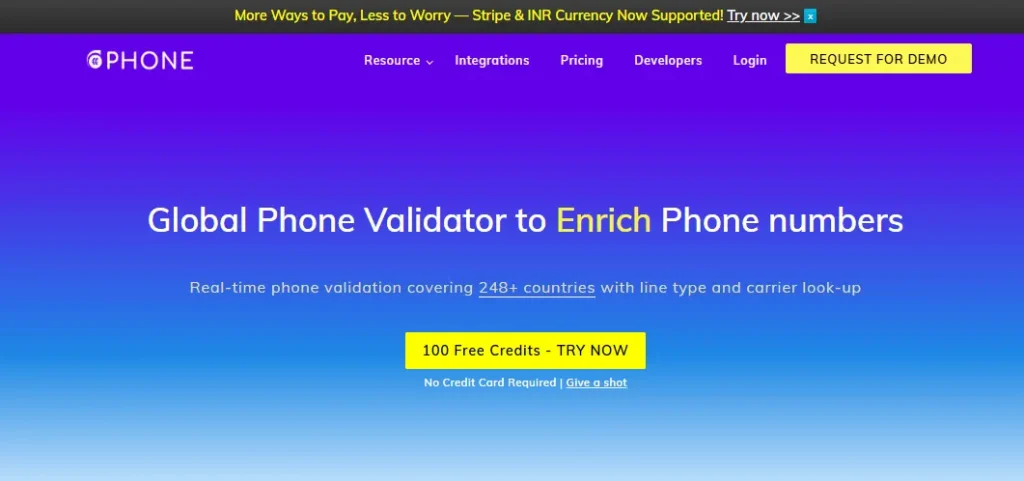Different Types of Mobile Marketing (With Case Studies & Tools)

You could be losing more than 70% of your customers without even realizing it. Why? Because the device people spend over seven hours a day on is the same device many businesses still ignore: the smartphone.
Think about it. Every second, someone makes a buying decision on their phone. While you’re reading this line, thousands of purchases are happening.
The real question isn’t “does mobile marketing work?” The question is, are you using it well enough to grab your share of a market?
Mobile channels drove about 57% of total online sales across the globe in 2024–25. Companies that still treat mobile as an afterthought are basically leaving money on the table.
So, businesses that treat mobile seriously are not just hanging in there. They’re pulling ahead, reaching customers faster, building stronger connections, and winning loyalty. If you get your mobile strategy right, you get ahead of competitors.
Want to know more about mobile marketing? Let's see all the details here.
Think about it. Every second, someone makes a buying decision on their phone. While you’re reading this line, thousands of purchases are happening.
The real question isn’t “does mobile marketing work?” The question is, are you using it well enough to grab your share of a market?
Mobile channels drove about 57% of total online sales across the globe in 2024–25. Companies that still treat mobile as an afterthought are basically leaving money on the table.
So, businesses that treat mobile seriously are not just hanging in there. They’re pulling ahead, reaching customers faster, building stronger connections, and winning loyalty. If you get your mobile strategy right, you get ahead of competitors.
Want to know more about mobile marketing? Let's see all the details here.
Table of Content
What Is Mobile Marketing?

How often do you check your phone each day? Dozens of times, right? But mobile marketing connects with people in the small moments of their daily routine, right on the device they can’t seem to put down.
1. Reaches People Where They Are
With texts and mobile apps, this form of marketing shows up on the devices people already use every day.
2. It’s Personal
Your phone knows a lot — your location, your favorite apps, even the time you usually wake up. Brands that respect this data can send messages that actually feel useful.
3. Different Ways to Connect
It could be a discount code via SMS, a push notification reminding you about your cart, or even an alert when you’re near a store.
4. Why People Respond
Phones are the most personal tech we own. If marketing feels like a helpful nudge instead of another noisy ad, people pay attention.
Components of Mobile Marketing
Let’s check out all the components here so you can see how it works.
1. Mobile Websites
Your site has to load fast, in under three seconds. People don’t wait around. With mobile shopping set to account for nearly 75% of e-commerce sales in 2025, a site that’s easy to use on a phone is non-negotiable.
2. Mobile Applications
Apps make it easier to connect with customers directly. They offer convenience, better service, and open a direct channel for communication. Push notifications, for example, let businesses send updates or offers instantly.
3. SMS and MMS Marketing
Text messaging still works incredibly well. With high open rates, SMS is one of the quickest ways to reach people.
4. Location-Based Marketing
With GPS or beacon tech, businesses can send give as per where someone is. What if you are walking near a store and receiving a discount code straight to your phone? This method drives people into physical stores while making offers feel timely.
5. Social Media Mobile Marketing
TikTok, Instagram, and Snapchat are mostly used on phones. Such content needs short attention spans and vertical screens. Quick videos, stories, and interactive posts work best here.
6. Mobile Advertising
Get banners, in-app ads, and short video ads built for mobile screens. They need to be easy to view on small devices since that’s where people are spending their time.
How Mobile Marketing Can Help Your Business

Where’s your phone right now? Probably in your hand or within arm’s reach. That’s exactly why mobile marketing is such a big deal. Businesses aren’t shouting from billboards anymore. They’re showing up right where people already spend hours every single day.
1. Reach That’s Hard to Ignore
By 2025, there will be more than 18 billion mobile devices. That’s more than people on the planet. So yes, your potential customers already carry the channel you need to talk to them.
2. Quick and Direct
Text messages get opened 98% of the time. But emails open only up to 20%. Also, push notifications reach people instantly within seconds.
3. Feels Personal
Phones know a lot about us; what we buy, where we go, and even when we usually shop. Done right, mobile marketing uses that info to send messages that actually feel useful instead of spammy.
4. Cheaper Than Old-school Ads
Why spend thousands on traditional ads when you can keep people coming back with simple mobile nudges? Push notifications alone can raise app activity by almost 88%. That’s huge without burning through a big budget.
What Are the Main Types of Mobile Marketing?

1. SMS Marketing
Timing and value matter most here. Domino’s Pizza made ordering simple with just a text.
Case Study: Sephora’s SMS Strategy
Sephora used SMS to drive sales and hit a 30% conversion rate. They did it by:
Case Study: Sephora’s SMS Strategy
Sephora used SMS to drive sales and hit a 30% conversion rate. They did it by:
- Sending messages based on customer preferences
- Offering exclusive deals through text only
- Sharing quick tips and tutorials
- Sending reminders for appointments
2. Mobile App Marketing
Apps give businesses room to give push notifications, rewards, and in-app offers while making people come back.
Case Study: Starbucks Mobile App
Starbucks built an app that now handles 25% of their transactions by:
Case Study: Starbucks Mobile App
Starbucks built an app that now handles 25% of their transactions by:
- Adding loyalty points for purchases
- Letting customers order and pay in-app
- Giving personalized offers
- Using gamified rewards to make it fun
3. Mobile Search Marketing
Most people search on their phones, often with voice commands. Local searches like “coffee near me” matter a lot here, and Google dominates with almost 94% of mobile searches worldwide.
4. Social Media Mobile Marketing
Platforms like TikTok and Instagram are designed for phones. Brands win here by creating short, vertical content.
Case Study: Nike on Instagram
Nike grew its presence by:
Case Study: Nike on Instagram
Nike grew its presence by:
- Using vertical videos built for mobile screens
- Adding interactive stories with shopping links
- Showcasing customer photos and videos
- Testing AR try-on features directly in the app
5. Location-Based Marketing
Using GPS, brands can send offers based on where someone is standing.
Case Study: McDonald’s Geofencing Campaign
McDonald’s ran a campaign targeting people near competitor restaurants. They increased visits by:
Case Study: McDonald’s Geofencing Campaign
McDonald’s ran a campaign targeting people near competitor restaurants. They increased visits by:
- Offering discounts or free coffee instantly
- Triggering offers based on weather
- Creating urgency with short time limits
6. Mobile Video Marketing
Short videos on phones grab more attention than desktop videos. In fact, mobile video ads perform almost twice as well as desktop ads.
7. Mobile Email Marketing
Emails that are easy to read on small screens matter. Short subject lines, layouts, and buttons that work well with thumbs make a huge difference.
8. QR Code Marketing
QR codes are back in action. From restaurant menus to payments, they connect offline experiences with online actions in just a scan.
Tools for Mobile Marketing
Let’s look at the tools that make a difference.

ClearoutPhone is a phone validation tool that validates numbers and even does bulk phone validation. It has features like looking for a carrier from where it belongs, line type, and even where it’s based.
It can be used right with your existing setup without any issues. So, you won't be wasting time or money on wrong numbers, undelivered texts, or calls that go nowhere.
Here’s what it does:
It can be used right with your existing setup without any issues. So, you won't be wasting time or money on wrong numbers, undelivered texts, or calls that go nowhere.
Here’s what it does:
- Validates numbers instantly so your SMS campaigns don’t bounce
- Enrich the numbers with line types, location, country, etc, for campaign segmentation
- Gives insights into carrier information for better delivery
- Works across 248+ countries
- Connects with popular marketing platforms
Why it matters: Invalid phone numbers can drain up to 40% of an SMS budget. ClearoutPhone stops that loss.
This Phone Validator doesn’t just check if a number is valid, it also fixes the formatting, figures out which carrier it belongs to, and even tells you the region, city, and time zone. Handy, right? You can plan your SMS or call campaigns as per this.
You can use it in real time by just plugging the API into your website or app, and only valid numbers will make it through.
This Phone Validator doesn’t just check if a number is valid, it also fixes the formatting, figures out which carrier it belongs to, and even tells you the region, city, and time zone. Handy, right? You can plan your SMS or call campaigns as per this.
You can use it in real time by just plugging the API into your website or app, and only valid numbers will make it through.
2. Mobile Analytics Platforms
Tools include:
- Google Analytics 4 (GA4) : great for mobile tracking
- Firebase : strong for app-specific analytics
- Mixpanel : detailed event tracking and user insights
3. SMS Marketing Platforms
Text campaigns still work wonders, and these platforms make it easier:
- Twilio : made for developers and enterprises
- Klaviyo : for e-commerce automation
- SimpleTexting : user-friendly for small to mid-sized businesses
Read more about Top SMS Marketing Platforms here.
4. Push Notification Services
Push notifications keep apps alive and active:
- OneSignal : widely used across platforms
- Firebase Cloud Messaging (FCM) : free and reliable for developers
- Airship : enterprise-grade with advanced targeting
5. Mobile App Development Platforms
Here are the best options:
👉 Flutter (by Google) : Super popular right now fast, and developer-friendly.
👉 Native iOS (Swift) & Android (Kotlin) : The “all-out custom” option when you want absolute control and top performance.
👉 Native iOS (Swift) & Android (Kotlin) : The “all-out custom” option when you want absolute control and top performance.
6. Location-Based Marketing Tools
Target people based on where they are:
- Foursquare : location data and audience insights
- PlaceIQ : helps understand customer movements
- Near : proximity-driven campaigns
7. Mobile Advertising Platforms
Run ads where people spend their time:
- Google Ads : tailored campaigns for mobile
- Facebook Ads Manager : strong for social promotions
- Apple Search Ads : ideal for promoting iOS apps
Pros and Cons of Mobile Marketing
Let’s see the positives and the not-so-good sides of mobile marketing:
Pros
- Targeting : Want to reach iPhone users in New York who use a fitness app? Mobile marketing lets you get that detailed.
- Better engagement : People open texts and tap mobile ads way more often than they do on desktop. More opens, more clicks, more sales.
- Easy to grow once it’s set up : If your mobile campaigns are rolling, you can scale them without spending a fortune.
- Fast feedback : You don’t have to wait weeks to see results. Mobile shows you right away if something is working.
Cons
- Privacy : With GDPR and Apple’s updates, you can’t just target people.
- So many devices, so little time : Different phones, systems, and screen sizes… testing can feel endless. But once you nail it, your campaign looks smooth everywhere.
- Competition is everywhere : Mobile is crowded, ads are nonstop. The trick is to stand out with personality.
- It gets a little techy : APIs, platforms, setups… not the most beginner-friendly stuff. But once you learn it, you’re a mobile wizard.
Final Thoughts
If your phone marketing campaigns are hitting fake or inactive numbers, you’re throwing money away. Businesses can lose a lot of their SMS budget this way.
ClearoutPhone fixes that problem. It verifies numbers before you launch a campaign, filters out invalid ones, and helps you reach people who actually exist.
Also, it works across various countries and connects easily with the tools you already use. If you want your mobile marketing to deliver real results, start with clean data.
Stop paying for dead numbers with ClearoutPhone.
ClearoutPhone fixes that problem. It verifies numbers before you launch a campaign, filters out invalid ones, and helps you reach people who actually exist.
Also, it works across various countries and connects easily with the tools you already use. If you want your mobile marketing to deliver real results, start with clean data.
Stop paying for dead numbers with ClearoutPhone.
Get 100 Free Credits
Search
Recent Posts
- 7 Proven Ways to Reduce SMS Marketing Costs and Boost ROI October 23, 2025
- 5 Best SMS Marketing Platforms in 2025 (Our Top Picks) August 28, 2025
- How to Send Bulk SMS in 2025: Step-by-Step Guide That Works August 18, 2025
- The Ultimate Guide to SMS Automation (2025 Edition) June 5, 2025
- 7 Reasons Why SMS Delivery Fails and How to Fix It in 2025 May 15, 2025
Phone Validation Service
Reach out to more real customers for your business
Create a free account with 100 credits
